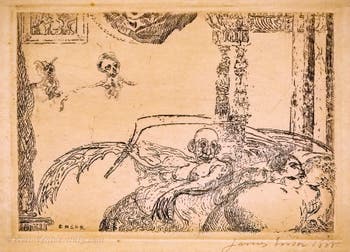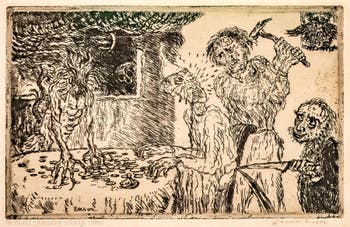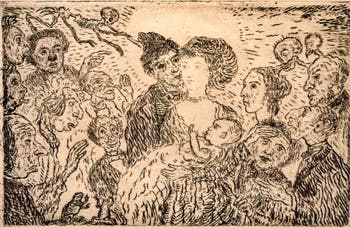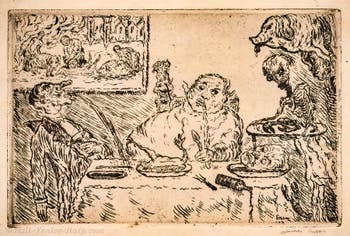Ca' Pesaro Artists | Location | Opening Hours Tickets | Authorizations
Artists Klimt | Chagall | Schiele | Bourdelle | Redon | Lichtenstein | Ensor | Wildt
James Ensor, "The Envy", "The Lust", "The Gluttony", "The Greed" at Ca' Pesaro International Modern Art Gallery in Venice Italy
At a banquet in his honour, James Ensor spoke for himself as follows:
“I was born in Ostend, April 13, 1860, on a Friday, the day of Venus. Well! Dear friends, Venus, from the dawn of my birth, came to me smiling, and we looked at each other long in the eyes.
Ah! Beautiful peers and green eyes, long hair colour of sand. Venus was blond and beautiful, all smeared with scum. She blossomed the salty sea well.
Quickly I painted her because she bit my brushes, ate my colours, coveted my painted shells, she ran on my mother-of-pearls, forgot herself in my conches, drooled on my brushes.”
James Ensor
James Ensor “The Lust” (La Luxure)
Drawing - Etching on beige paper (9.2 x 13.2 cm) 1888
James Ensor, The Lust The four drawings and etching exhibited at Ca'Pesaro are part of the seven deadly sins: Lust, Laziness, Wrath, Pride, Greed, Gluttony and Envy.
Émile Verhaeren described them in his 1908 book on James Ensor.
“The seven deadly sins [...] offer us a cyclical work where the grotesque disputes him with ferocity.
A preliminary etching prepares the strange impression, showing a Winged Death —look at wretched and unfeathered wings the skeleton opens! — sheltering under them various characters, each of which seems to be a quick indication of the seven vices to castigate.
“The Lust” occupies the centre of the work.
A young man whose body is half-hidden seems to crawl, on a bed, towards a huge woman who turns her head away and spreads only an immodest and monstrous bloated flesh.
Time, a sinister and glabrous older man, time with crooked hands and wings threatens with a giant scythe the lusty couple, while a horned gnome is fluttering in the air; and in a frame, near a curtain appear some vague nudities.
James Ensor “The Greed” (L’Avarice)
Drawing - Drypoint on paper - (9.9 x 15 cm) 1904
James Ensor, The Greed A quick drawing, small lines, fine and delicate craft.
Page of blond and youth where only the lifted scythe traces out moody lighting.
It neighbours with “The Greed”.
Here, the tip of the chisel presses, claws, becomes like wicked — and one sees a terrible man, in a helmet counting his money on a table and some bristled demon stirring, with him, the round and quivering coins.
Suddenly two murderers assault and bleed the miserly cynical, blood splashing his face and flowing from his flank.
“The Envy” is illuminated by the appearance of a young mother holding a newborn in her arms.
James Ensor “The Envy” (L’Envie)
Drawing - Drypoint on straw yellow paper (9.9 x 15.1cm) 1904
James Ensor, The Envy She's happy. A young guy kisses her.
Peace, sweetness, tenderness is widespread.
Luminous rays leave from the middle of the page, bathing the woman's forehead and projecting to the edge of the frame.
But here contradiction arises: old girls with fierce noses, bigots pulling the tongue, serious and bilious men, morons making nose feet and here and there some skeletons flying like to announce disease and demise and affirm how always Death is suspended on life.
Here the tremendous and greasy and rotting and tasty “The Gluttony”.
James Ensor “The Gluttony” (La Gloutonnerie)
Drawing - Drypoint on paper (9.7 x 15.1cm) 1904
James Ensor, The Gluttony Although the two seated characters vomit their food and Death serves them a lobster, and a dog on the back of a chair pees on one of them.
A cut head spreading over a dish, the small gastronomic drama is characterized by fun joviality.
A painting hanging on the wall rejoices with its drawing: it depicts pigs that are killed in a village's square, and indeed, the two greedy men sitting or somewhat slumped at their table do not suspect that they deserve a similar demise.
In a corner, a huge pig rises with its tongue hanging, and it seems the one to distract the fatty man whose oblique eye goes towards its snout or to the lobster that Death brings, almost lovingly.
This suite of subjects informs — and other small plates say so — about James Ensor's inexhaustible fantasy.
It is believed at the end of its hustle and bustle, but it always starts again.
It is swift and constant, like the ticking of a watch. It works day and night.
The slightest random observation winds it up, as the small daily key's turn brings back life to the distended springs”
Emile Verhaeren - James Ensor - 1908.
Artists Klimt | Chagall | Schiele | Bourdelle | Redon | Lichtenstein | Ensor | Wildt
Ca' Pesaro Artists | Location | Opening Hours Tickets | Authorizations
Back to Top of Page




